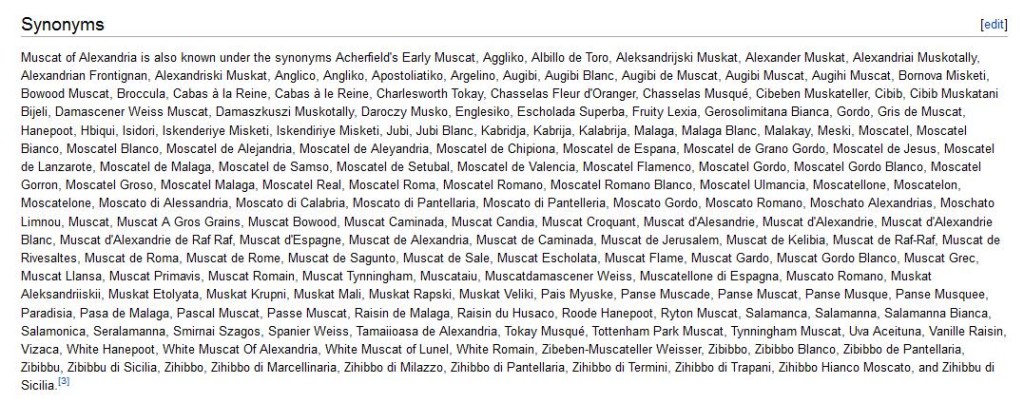The “Who’s Your Daddy” series takes a very brief look at the parentage of grapes, in order to get a better understanding of where particular varietals come from and how they are genetically related to one another. So far, we’ve covered: Cabernet Sauvignon, Chardonnay, Gamay, Merlot, Nebbiolo, Petite Sirah, Petit Verdot, Pinotage, Pošip bijeli, Sangiovese, Syrah, Tempranillo, and Torrentés riojano. Feel free to click on any one of the varietal names to read all about their parentage.
The subject of today’s “Who’s Your Daddy” post is the Muscat grape, which comes by special request from a reader!
Now, I don’t really know a lot about Muscat, other than general flavors associated with it, so I was quite surprised to find out there are about a billion different synonyms for this grape, and I’m not quite sure if they are actually the same grape under a bunch of names, or if they are really many different varieties of grape that aren’t that closely related to one another. Just typing “muscat” into Wikipedia (I know, I know, not the best source, but it’s always a decent starting point), I was met with a wall of text describing the many names Muscat is known for. In fact, here’s a screen shot of the different names for Muscat:
Of course, it would take me forever to go through every single one of those to figure out what’s what, so for this simple post, I did a literature search for “genetic origins of muscat” and stumbled across an article from 2008 by Schneider et al examining the genetic origins of the Muscat fleur d’oranger variety (you can find the name somewhere in the mess of text in the image above). I’m working under the assumption that all Muscat grapes are very closely related, and that the parentage found for Muscat fleur d’oranger is the same for many of the other Muscat variety grapes (feel free to correct me if I’m wrong!).
The Muscat grape is thought to be a very ancient grape, and possibly one of the first grapes to be domesticated. According to sources, there are over 100 Muscat varieties, which makes sense from an evolutionary stand point—if it is a really old variety, it’s likely that over time Muscat grapes would diverge slightly in their genetic make-up depending upon where they were brought to grow and what environmental conditions they were forced to adapt to. This resulted in many different varieties, ranging from various aromas and flavors and colors from white to dark.
Muscat grape varieties are grown all over the world in all different growing conditions, as each variation of the grape has adapted itself to different environmental areas. Wines made from Muscat grapes are extremely popular, with “Moscato” in the United States picking up tremendous steam in the past few years. Often a very fruity and floral wine (vague, I know, sorry), it often is made with a bit of residual sugar, and at times levels high enough to be classified as “dessert wines”. In addition to table wines and dessert wines, Moscato wine can also be made into a sparkling form, which has had a lot of success particularly in the United States. For more great reading on Moscato, check out this article from the Wine Spectator published a little over a year ago.
So, Who’s Your Daddy, Muscat?
The particular variety of grape examined in the 2008 paper I mentioned above examined the Muscat fleur d’oranger variety. According to the paper, this variety has “muscat flavor and a particular note of orange blossom”. Based on genetic and ampelography trace data, the parental genetic origin of Muscat fleur d’oranger is:
Chasselas…..

…..and….
Muscat a petits grains blanc (Muscat blanc)!
There you have it! I’m not certain I addressed the questions my reader who requested the grape wanted answered, but alas, the Muscat grape appears to have a very complicated history with there being over 100 varieties and/or names now, and we’re not even close to genetically analyzing every single one of them!
If you have other grapes you’d like to learn the origin of, please feel free to ask! I can’t promise there is any information regarding your particular grape of interest, but I can certainly try to look! Please feel free to comment!


![By Viala et Vermorel (Ampélographie) [Public domain], via Wikimedia Commons](http://www.academicwino.com/wp-content/uploads/2013/03/Muscat_blanc_The_Academic_Wino-194x300.jpg)